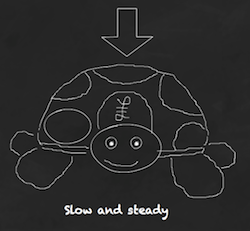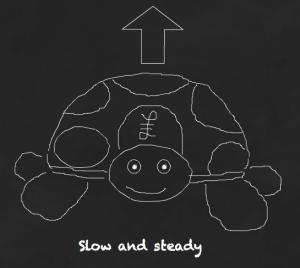No prizes for guessing which way our Slow and Steady passive portfolio went this quarter.
We went south. Deep south.
Us and the rest of the world were up against a global backdrop of fear and loathing that can be summed up in three words:
SOVEREIGN DEBT CRISIS!
Let’s do a breathless recap of events since the beginning of July.
The Slow and Steady model portfolio was set up at the start of the year with £3,000. An extra £750 is invested every quarter into a diversified set of index funds, heavily tilted towards equities. You can read the original story and catch up on all the previous passive portfolio posts.
July jitters
- The Greek contagion laps at the shores of Spain and Italy, sending their bond yields above an eye-watering 6% – a Euro era record.
- US GDP figures are revised down, consumer spending is down for the first time in two years.
- The showdown between US lawmakers spooks markets with fears of a US debt default.
- Growth stagnates across Europe. UK growth undershoots government predictions and gilt yields fall to a 50-year low.
August agony
- US loses its Triple A rating after a downgrade by debt rating agency S&P.
- Equity markets fall steeply as global recession fears stalk investors.
- IMF revises down growth expectations for much of the developed world.
- The Federal Reserve declares that interest rates are on hold until 2013.
- UK gilt yields hit an all time low.
September seizures
- Greek debt default now assumed to be inevitable.
- Poor US employment figures.
- US housing market down.
- UK retail sales fall.
- Federal Reserve announces Operation Twist instead of QE3. Markets slump and keep on slumping.
- Eurozone politicians still trying to pass measures agreed in July to tackle Eurozone crisis. Measures widely agreed to be already obsolete.
Blood on the carpet
Obviously that’s not intended to be a comprehensive round-up of market influences. It’s a broad-brush summary of the incessant drip-feed of bad news that’s got investors grinding their worry beads into dust.
So where does all that leave our portfolio?
Well, for the first time, we’re up to our waists in red ink. Passive investing may be wise but it can’t insulate investors from a global rout.
We’re down 9.32% since January and have lost £419.43 on the £4499.95 invested so far.
Equities have taken an all-round kicking. The FTSE is down nigh on 14% this quarter and the French and German bourses are down by over 25%.
Our gilt allocation is valiantly pulling the counter-weight in the opposite direction but it’s little more than a sticking plaster over a severed artery. The Slow and steady portfolio is aggressively tilted towards equities (80%) and we’re paying the price in volatility now.
The good news is we’re on a 20-year plan so the portfolio has plenty of time to recover and indeed be buffeted by quarters far worse than the last one.
We have to view this as an opportunity to buy equities on the cheap – our rebalancing strategy and regular contributions enable us to buy more units when prices are low, so the portfolio should do well when stock markets recover.
New purchases
With slightly shaky hands it’s time to throw another £750 into the mixer:
UK equity
HSBC FTSE All Share Index – TER 0.27%
Fund identifier: GB0000438233
New purchase: £180.18
Buy 59.1905 units @ 304.4p
Target allocation: 20%
Developed World ex UK equities
Split between four funds covering North America, Europe, the developed Pacific and Japan.
Target allocation (across the following four funds): 50%
North American equities
HSBC American Index – TER 0.25%
Fund identifier: GB0000470418
New purchase: £204.96
Buy 119.2296 units @ 171.9p
Target allocation: 27.5%
(Happy note: The fund TER has been cut from 0.28% so we’re losing less to costs).
European equities excluding UK
HSBC European Index – TER 0.31%
Fund identifier: GB0000469071
New purchase: £171.18
Buy 43.2919 units @ 395.4p
Target allocation: 12.5%
(The fund TER has been cut from 0.37%).
Japanese equities
HSBC Japan Index – TER 0.29%
Fund identifier: GB0000150374
New purchase: £23.59
Buy 39.0699 units @ 60.37p
Target allocation: 5%
(TER has increased from 0.27%. Boo.)
Pacific equities excluding Japan
HSBC Pacific Index – TER 0.37%
Fund identifier: GB0000150713
New purchase: £57.10
Buy 28.6055 units @ 199.6p
Target allocation: 5%
Emerging market equities
Legal & General Global Emerging Markets Index Fund – TER 0.98%
Fund identifier: GB00B4MBFN60
New purchase: £122.32
Buy 297.189 units @ 41.16p
Target allocation: 10%
(The fund TER has been cut from 0.99%).
UK Gilts
L&G All Stocks Gilt Index Trust: TER 0.25%
Fund identifier: GB0002051406
Rebalancing sale: £9.31
Sell 5.4026 units @ 172.40p
Target allocation: 20%
Exciting development: Our equity losses have been so bad that for the first time we need to sell gilts in order to keep within our 20% asset allocation for government bonds. This may seem counter-intuitive, but it’s the essence of rebalancing.
We’re pruning back the over-performing asset in order to raise the funds to buy under-performers – in other words we’re selling high and buying low.
Total cost = £750
Total cash = 5p
Trading cost = £0
A reminder on rebalancing: This portfolio is rebalanced to target allocations every quarter, mostly using new contributions. It’s no problem to do as our vanilla index funds don’t incur trading costs.
Take it steady,
The Accumulator








Comments on this entry are closed.
And the pain is not over yet!
If I look at my own ‘income’ portfolio over the same period, although the capital value is down (by around 4%), the income level hasn’t really moved. Not saying its better in the long run, just makes it easier to weather the storm!
rebalancing every quarter – thats keen
i need to buck my ideas up in that department
i also like that you keep tabs on all the TERs
although 6% of ~0.3% maybe isn’t a lot its good to know how they vary over time
but you’re not accounting for spread in terms of your costs when you have to sell?
@ Moneyman – I fear you’re right. Though a long bear run will be good for the portfolio in the long run, it means a lot of turbulence and potential misery ahead.
@ Ben – there is no spread on any of these funds and no trading costs.
-im only just begginning and find this website really informative so thanks.
-what do you think of my strategy which i started when FTSE was around 5300: ive basically copied your portfolio of index trackers. i am drip feeding in a low amount £50 or £100 into each one everytime they go below my average, thereby constantly lowering my average and following the market down. the aim is to capture every new low and not miss the bottom. on a significant rally i can consider taking profits to re-invest or hold for long-term
Its alright as long as the markets keep falling, but otherwise you’ll never invest any new capital.
So likelihood is that over the long term you won’t invest much, so any returns you make from the market will be limited whilst you’ll generate a massive pile of cash. So your strategy limits your ability to control your asset allocation (which is a bad thing).
Just remove the constraint of only investing when the market index is lower than your previous investment and you’re back to pound cost averaging which is widely considered to be a pretty sensible approach
Was there a particular reason why the conventional UK government bonds index (L & G All Stock Gilt Index fund) was chosen over index linked government bond tracker fund?
@ Alan – yes, because the equity portion will hopefully handle unexpected inflation scenarios while the conventional bonds will perform well during bouts of deflation.
There is an L&G index linked Gilts fund if you wanted to split your bond allocation between the two.
Thanks for reporting this, it is a useful benchmark!
What do you mean by the references “TER has been cut by 3%”? Is that on an absolute scale, their total charges extracted from the fund dropped by 3%? Or relative to the fund size, somehow?
0.27-(0.27*0.03) = 0.2619
i.e. a 0.27% TER cut by 3% is now a 0.2619% TER
is that the gist of it?
Sorry, that was a blunder on every level. Whereas TER was 0.28% it is now 0.25%.